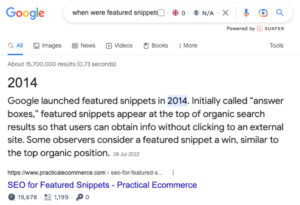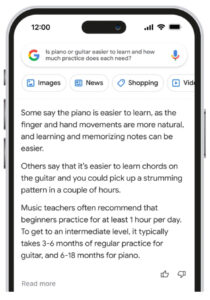Is Bard the next step in the evolution of the web? Since Google announced Bard in early Feb 2023, clients, staff and non-marketing folk alike are eagerly awaiting the official release. But what exactly is Bard and what do business owners need to know about it (if anything)? We’ve answered your most popular questions below.
What is Bard?
Bard is described as a ‘conversational AI service’ which will eventually be accessible via Google Search according to Googles press release material. Bard uses a language model for ‘dialogue applications,’ allowing users to interact, ask questions and gather information in a natural way. In short – it’s a chat bot that seemingly sits within Google search – but may be available as a standalone application (similar to Chat GPT).
More recently, Google reminded employees that ‘Bard is not search’ – meaning users may not use it in the same way they currently do with search. According to Jack Krawczyk, “the product is really around being this creative companion to helping you be the sparkplug for imagination, explore your curiosity, etc. (View source).”
How will Bard Look In Search Results?
You may be familiar with featured snippets – the larger block of text that appears above the first organic position fondly referred to as ‘position zero’ in the search community. Here’s how the featured snippets currently look in search results – with relevant text pulled directly from a search result.

According to the graphics released by Google, Bard (or at least the answers that Bard may produce) may be replacing featured snippets with a slightly longer AI-generated snippet on mobile.
You may not even notice too much of a change straight away. Unless you’re studying search results on a daily basis, you may not even immediately notice that the text is not pulled from a piece of existing content as is currently the case.
There is no website to click through to as this text will be generated by Google – but these images are just prototypes at present – we’re yet to see what this will look like ‘in the wild.’

How does it actually work?
Bard effectively draws on information crawled via the content crawled and indexed by Google. In short – Bard ‘learns’ and collates information from websites (but only information up to the year 2021).
Since its inception in 1998, Google has indexed ALOT of content and information. Over the years, Google has set out to create an algorithm to try to ‘crawl’ and rank content based on a number of ‘on page’ factors’ from mentions of the text used on the page as well as the text used to link back to the website.
Fast forward to 2023, the algorithm is of course much more sophisticated and considers hundreds of ‘ranking factors’ – but the real breakthrough has been the use of AI to better ‘understand’ content and language.
Through machine learning and other AI and language processing protocols, Google has made strides in recent years to better understand the context of user enquiries and serve highligh relevant results. Google now knows what you ‘mean’ as opposed to what you actually typed in search engines.
From RankBrain (2015), a machine learning component of Googles algorithm which attempts to learn the context of a search, to BERT (2019) – Googles protocol for natural language processing – it’s clear that Google has been developing this iteration of search results for a number of years.
What does this update mean for my website / business?
This is perhaps the most important question and one that is yet to be fully answered. The effects of the change are still largely unknown as we’re yet to see the final iteration of Bard live in search results. As we’ve never seen disruption like this in search results, it’s unknown how users will respond or interact with Bard. This update could change user or search behaviour forever.
However, based on what we have seen in the limited information / imagery released by Google, some sites may lose some search visibility – but perhaps only for blog-related content. As it stands, if your site was ranking in ‘position 0’ for a particular phrase, your result may be replaced with a BARD result.
Further to this, it’s likely that the 1st position in Google will lose real estate in Google Search results, resulting in fewer clicks. This means being ‘top of Google’ will be even more competitive going forward – with more competition for the coveted top spots.
We’re yet to see if Google will give reference to website URLS in its AI answers. If this is the case, we actually see organic traffic increase as users click through to see the source of the content.
What is clear (and has always been the case) is that businesses should never rely on one traffic source. The businesses that may suffer the most are those that solely rely on organic traffic to generate leads and enquiries. The importance of branded traffic as well investing in multi channel marketing campaigns is higher than ever.
When will Bard be released
Bard was set to be in its final phase of testing at the end of February. However, after a series of leaked tests that produced factual errors and the resulting bad press and a loss of $100B in Alphabet share price – it appears that Google are not looking to rush the launch!
If you’re looking for more information about Bard, get in touch with the experts at Sixtwo today by filling out a contact form, or give us a call on 01233 333824.
Get in touch to find the perfect package for you